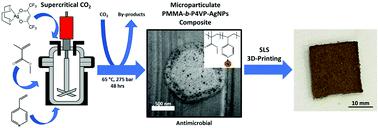当前位置:
X-MOL 学术
›
Polym. Chem.
›
论文详情
Our official English website, www.x-mol.net, welcomes your
feedback! (Note: you will need to create a separate account there.)
Antimicrobial ‘inks’ for 3D printing: block copolymer-silver nanoparticle composites synthesised using supercritical CO2
Polymer Chemistry ( IF 4.1 ) Pub Date : 2022-06-07 , DOI: 10.1039/d2py00398h Ryan R. Larder 1 , Eduards Krumins 1, 2 , Philippa L. Jacob 1 , Kristoffer Kortsen 1 , Robert Cavanagh 3 , Long Jiang 3 , Claudia Vuotto 4 , Iolanda Francolini 5 , Christopher Tuck 2 , Vincenzo Taresco 1 , Steven M. Howdle 1
Polymer Chemistry ( IF 4.1 ) Pub Date : 2022-06-07 , DOI: 10.1039/d2py00398h Ryan R. Larder 1 , Eduards Krumins 1, 2 , Philippa L. Jacob 1 , Kristoffer Kortsen 1 , Robert Cavanagh 3 , Long Jiang 3 , Claudia Vuotto 4 , Iolanda Francolini 5 , Christopher Tuck 2 , Vincenzo Taresco 1 , Steven M. Howdle 1
Affiliation

|
Silver nanoparticles (AgNP) are widely exploited for their effective antimicrobial activity against a range of pathogens. Their high efficacy in this regard has seen the global demand for AgNP in consumer products steadily increase in recent years, necessitating research into novel low environmental impact synthesis approaches. Here we present a new synthetic methodology to produce polymer-AgNP composite microparticles using supercritical carbon dioxide (scCO2) and avoiding use of any petrochemically derived solvents. Poly(methyl methacrylate)-poly(4-vinylpyridine) (PMMA-b-P4VP) block copolymers were synthesised via RAFT-mediated dispersion polymerisation in scCO2, with in situ thermal degradation of various amounts of a CO2-soluble silver complex. Selective interaction of the silver with the pyridinyl moieties of the block copolymer allowed the formation of AgNP, dispersed within the block copolymer microparticles, leading to homogeneous composites. The by-products of the reaction were also removed by extracting with a flow of CO2 to yield a clean dry product in a single process. The composites were found to be non-cytotoxic and proved to have good antimicrobial activity against two bacterial strains. Though no significant activity was seen for at least the first 24 hours, inhibition of bacterial growth afterwards proved to be extremely persistent, with inhibition observed even after 15 days. Finally, the microparticulate nature of the synthesised composites was exploited and tested for compatibility in the Laser Sintering (LS) 3D printing process. Composite microparticles were fused to produce solid objects, without aggregation of the AgNP. With further optimisation, these composites could prove to be an incredibly versatile ‘ink’ that may be used within additive manufacturing and 3D printing to rapidly produce bespoke medical devices with inherent antimicrobial activity.
中文翻译:

用于 3D 打印的抗菌“墨水”:使用超临界 CO2 合成的嵌段共聚物-银纳米颗粒复合材料
银纳米粒子 (AgNP) 因其对一系列病原体的有效抗菌活性而被广泛开发。近年来,它们在这方面的高效率已经看到全球对 AgNP 在消费品中的需求稳步增长,因此需要研究新的低环境影响合成方法。在这里,我们提出了一种使用超临界二氧化碳 (scCO 2 ) 生产聚合物-AgNP 复合微粒的新合成方法,并避免使用任何石油化学衍生的溶剂。聚(甲基丙烯酸甲酯)-聚(4-乙烯基吡啶)(PMMA- b - P4VP)嵌段共聚物通过RAFT 介导的scCO 2分散聚合,原位合成不同量的CO 2可溶性银络合物的热降解。银与嵌段共聚物的吡啶基部分的选择性相互作用允许形成分散在嵌段共聚物微粒中的 AgNP,从而形成均匀的复合材料。反应的副产物也通过用CO 2流萃取除去在单个过程中产生清洁干燥的产品。该复合材料被发现是无细胞毒性的,并被证明对两种细菌菌株具有良好的抗菌活性。尽管至少在最初的 24 小时内没有观察到明显的活性,但后来证明对细菌生长的抑制非常持久,甚至在 15 天后也观察到了抑制。最后,利用合成复合材料的微粒性质并测试其在激光烧结 (LS) 3D 打印过程中的兼容性。复合微粒被融合以产生固体物体,而没有 AgNP 的聚集。通过进一步优化,这些复合材料可能被证明是一种用途广泛的“墨水”,可用于增材制造和 3D 打印,以快速生产具有固有抗菌活性的定制医疗设备。
更新日期:2022-06-10
中文翻译:

用于 3D 打印的抗菌“墨水”:使用超临界 CO2 合成的嵌段共聚物-银纳米颗粒复合材料
银纳米粒子 (AgNP) 因其对一系列病原体的有效抗菌活性而被广泛开发。近年来,它们在这方面的高效率已经看到全球对 AgNP 在消费品中的需求稳步增长,因此需要研究新的低环境影响合成方法。在这里,我们提出了一种使用超临界二氧化碳 (scCO 2 ) 生产聚合物-AgNP 复合微粒的新合成方法,并避免使用任何石油化学衍生的溶剂。聚(甲基丙烯酸甲酯)-聚(4-乙烯基吡啶)(PMMA- b - P4VP)嵌段共聚物通过RAFT 介导的scCO 2分散聚合,原位合成不同量的CO 2可溶性银络合物的热降解。银与嵌段共聚物的吡啶基部分的选择性相互作用允许形成分散在嵌段共聚物微粒中的 AgNP,从而形成均匀的复合材料。反应的副产物也通过用CO 2流萃取除去在单个过程中产生清洁干燥的产品。该复合材料被发现是无细胞毒性的,并被证明对两种细菌菌株具有良好的抗菌活性。尽管至少在最初的 24 小时内没有观察到明显的活性,但后来证明对细菌生长的抑制非常持久,甚至在 15 天后也观察到了抑制。最后,利用合成复合材料的微粒性质并测试其在激光烧结 (LS) 3D 打印过程中的兼容性。复合微粒被融合以产生固体物体,而没有 AgNP 的聚集。通过进一步优化,这些复合材料可能被证明是一种用途广泛的“墨水”,可用于增材制造和 3D 打印,以快速生产具有固有抗菌活性的定制医疗设备。











































 京公网安备 11010802027423号
京公网安备 11010802027423号